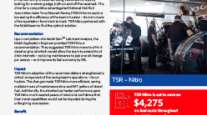Diesel Falls 4.2¢ to $4.085, Slips Below Year-Ago Level
This story appears in the April 30 print edition of Transport Topics.
Retail diesel prices dropped by 4.2 cents a gallon to $4.085 last week — the second straight decline — after hitting the high point for this year, the Department of Energy reported.
A year ago, the average diesel price actually was higher, $4.098. The latest time diesel was less expensive on a year-over-year basis was in November 2009. Diesel started the year at the relative low point of $3.783 on Jan. 2 and then shot up to a high of $4.148 on April 9.
DOE also said in its April 23 report by the Energy Information Administration that gasoline prices fell by 5.2 cents to $3.87 a gallon, the third weekly decline after it peaked for the year.
A year ago the average price of gas was $3.879, making it cheaper year-over-year for the first time since October 2009. Gasoline hit a 52-week low on Dec. 19 at $3.229 and then soared to $3.941 on April 2.
The prices for refined products have followed the decline in crude oil, which has backed off of price spikes in February and early March.
U.S. diesel and gasoline should continue to drift down in the immediate future and then diverge, said Tom Kloza, chief oil analyst for the Oil Price Information Service, Wall, N.J.
“There is the strong basis for a rally being set for diesel prices during the second half of the year. Diesel will hit bottom within 90 days,” Kloza predicted, and then prices should start rising on the strength of global economic activity.
Gasoline is used most heavily in the United States, whereas diesel is a globally desired commodity.
Trucking company executives said any decline in diesel prices is always welcome, as is a calming down in violent price swings, but there is no expectation of long-term price declines.
“I expect a gentle drift down through the election, and then I think we’ll get hammered again,” said Jim Jeter, general manager of Trans Gulf Transportation. The La Porte, Texas, carrier does intermodal drayage work, and Jeter said fuel surcharges can add 21% to 34% to the cost of hauling a cargo container.
“If we can manage to cut 2 or 3 cents a gallon, it becomes a very big thing,” said Don Piontek, fuel and license manager for Trans-System Inc., Spokane, Wash.
“We purchase about 1.2 million gallons of diesel per month, so that adds up,” said Piontek, whose employer runs about 930 tractors for a diversified menu of transportation services.
Piontek said that, for now, he is paying most attention to the domestic and global economies. To the extent they improve, he said, that should determine how fast diesel prices rise.
The Federal Reserve expects the domestic economy to improve slowly, and that boosted crude oil prices slightly on April 25, Bloomberg News reported.
Futures climbed by 0.6% on April 25 after the Federal Open Market Committee said it “expects economic growth to remain moderate over coming quarters and then to pick up gradually,” Bloomberg reported.
“We’re seeing an impact of the Fed statement in all the markets,” John Kilduff, a partner at Again Capital, a New York hedge fund, told the wire service. “The fact that the economy is expected to grow is good for demand.”
Crude oil futures on the New York Mercantile Exchange have been trading within a narrow band since April 3, with the closing price fluctuating above $101 a barrel but below $104.60. On April 26, oil closed at $104.55, the 17th trading day within that range.
The high close for crude this year was $109.77 on Feb. 24. Last year’s high was $113.93 in late April.
Worries about a potential altercation with Iran drove up prices earlier this year, and OPIS’s Kloza said Iran is still the key issue to watch. He said crude prices have been too high recently, and absent a crisis concerning Iran, they should remain stable or go down.
Brent crude, the London-based futures contract that is followed internationally, dropped below $120 a barrel last week after topping $126 on March 13.
In terms of domestic supplies, the U.S. stockpile of crude oil grew to 369 million barrels on April 20 from 365.2 million barrels the week before. In contrast, the supply of ultra-low-sulfur distillate — the basis of diesel — tightened as did the gasoline stockpile, the Energy Department said April 25.




